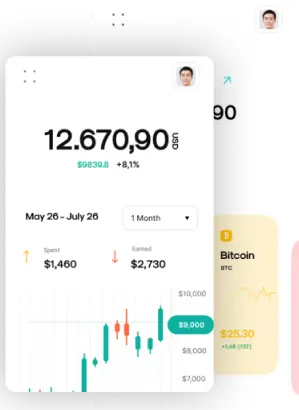- Build
- Improve
- Validate
- Conduct
- Forge
Build a new product
Our team can help you create a product concept and verify functionality to complete MVP with real value for your users.
This approach works well if you start from scratch or want to completely rebuild your product.

Research
- Call / Meeting with your team
- Online Surveys
- UX Research
- Qualitative & Quantitative Research
- 1-5 days

Creative Workshop
- Design Sprint
- Brainstorming
- Design Thinking
- Other creative workshops tailored to your needs
- 1-5 days

Usability tests
- Creating test scenarios
- Facilitating user tests
- Recruiting respondents
- Interpreting the test results
- 1-3 days

UX & UI Concepts
- Wireframes & prototypes
- Graphical concepts
- Iconography & animations
- Design system
- UX writing
- 3-10 days
What do we use to build a new product?
- It helps answer the questions: how many? How often? How much? Quantitative research aims to evaluate the data and usability of an existing product.
- Answers the question: why? Qualitative research aims to influence design decisions and address usability issues.
- These are a series of questions posed to several users that help researchers learn about the individuals who use the end product.
- The Design Sprint is a five-stage workshop. It is a quick and inexpensive way to validate hypotheses. The workshop consists of the following steps: – finding and understanding the problem, – identifying potential solutions to the problem, – visualizing solutions to the problem, – selecting a solution to work on and preparing a realistic prototype.
- A design method for generating ideas to solve a predefined design problem. Ideas are generated by answering “How might we…?” questions. This technique creates multiple views and makes connections between them to potentially find the best solution.
- Usability testing is one of the most effective methods of verifying if solutions are user-friendly and correspond to business goals. These tests allow us to check how users navigate the software or website and see where they encounter problems understanding the content or performing an action.
- Wireframing is the stage at which we create high-level (lo-fi) concept mockups. They are not intended to visually represent the interface, only the information architecture and functional design, i.e. how the product will meet the users’ objectives.
- For usability testing and validation, a product prototype is prepared to achieve the greatest possible visual similarity and a close approximation of operation to the final product. Work on the prototype begins with creating the entire prototype layout, followed by detailed prototyping of the individual screens.
- This is a set of guidelines and standard elements (components) for designing and developing a digital product. It responds to all questions and concerns about the product’s appearance for all those involved in production. The design system’s role is to provide a consistent visual language for the product.
- This is the writing of texts in a simple language that every user can understand. The most important thing here is to have a clear message and basic vocabulary that assimilates messages faster and eliminates difficulties in reading our intentions.
Improve an existing solution
Using our expertise, we can review your product to pinpoint where improvements will matter the most to your users.
This approach works well if you already have a working solution and want to upgrade the overall look and visual impact, add new functions or incorporate new ideas into your product.

Expert review
- Research
- Competition analysis
- User interviews
- UX consulting
- 3-5 days

Usability audit
- An audit of your product
- Lightning Decision Jam
- Full usability report & presentation
- 1-5 days

Prototyping & Testing
- Wireframing & prototyping
- UX writing
- Facilitating user tests
- Interpreting test results
- 3-10 days

UI Redesign
- Graphical concepts
- Iconography & animations
- Design system
- Responsive design
- 5-14 days
What do we use to improve your product?
- Usability testing is one of the most effective methods of verifying if solutions are user-friendly and correspond to business goals. The tests allow us to check how users navigate the software or website and see where they encounter problems understanding content or performing an action.
- Wireframing is the stage at which we create high-level (lo-fi) concept mockups. They are not intended to visually represent the interface, only the information architecture and functional design, i.e. how the product will meet the users’ objectives.
- For usability testing and validation, a product prototype is prepared to achieve the greatest possible visual similarity and a close approximation of operation to the final product. Work on the prototype begins with creating the entire prototype layout, followed by detailed prototyping of the individual screens.
- This is a set of guidelines and standard elements (components) for designing and developing a digital product. It responds to all questions and concerns about the product’s appearance for all thoser involved in production. The design system’s role is to provide a consistent visual language for the product.
- This is the writing of texts in a simple language that every user can understand. The most important thing here is to have a clear message and basic vocabulary that assimilates messages faster and eliminates difficulties in reading our intentions.
- This is the design of interactive products to provide users a positive experience. A well-designed digital product should be attractive to the user, as well as functional and usable. User Experience Design determines how a product should behave in response to user actions.
- This approach allows the design and layout to automatically adapt to different mobile devices and screen sizes or browser windows. The characteristic of such a site is its versatility.
- This is an exercise designed for companies that can’t find the source of their problems. LDJ allows them to identify and define the issues and develop multiple solutions (often very creative or obvious solutions that may have been overlooked).
- A method that enables rapid iterations and improvements to a product. The highest value of an audit is the professional collation of the tested solution’s most significant advantages and disadvantages. The result is an audit report that includes a heuristic analysis, cognitive review and expert assessment.
Validate your product
We can help you with testing and evaluating your solution or prototype. We will watch, listen and talk to your customers as they engage with your product.
Our experienced team can also provide a report with solid recommendations based on an expert review, research and market analysis.

Preparation
- Defining key objectives
- Recruiting respondents
- Creating test scenarios
- Setting a time & place for user testing
- 3-5 days

Usability tests
- Facilitating user tests
- Streaming or recording during tests
- Workshops & collecting feedback
- 1-2 days

Report
- Survey summary
- Results analysis
- Conclusions and suggestions for improvements
- 3-5 days

Presentation & next steps
- Results presentation
- UX consulting
- Wireframing & UI design
- 1-10 days
What do we use to validate your product?
- Usability testing is one of the most effective methods of verifying if solutions are user-friendly and correspond to business goals. Tests allow us to check how users navigate the software or website and where they encounter problems understanding content or performing an action.
- Wireframing is the stage at which we create high-level (lo-fi) concept mockups. They are not intended to visually represent the interface, only the information architecture and functional design, i.e. how the product will meet the users’ objectives.
- This is the design of interactive products providing users a positive experience. A well-designed digital product should be attractive to the user, as well as functional and usable. User Experience Design determines how a product should behave in response to user actions.
- Focuses on the visual layer of digital products. It includes the selection of appropriate fonts, icons, colors and images, as well as capturing a suitable space between elements. The “UI” encompasses all the aspects of the virtual product, such as buttons, forms, frames and tables.
Conduct Creative Workshop
Do you want to quickly test different approaches to your issues? Or maybe find the best way to solve the main problems in your project or team?
We provide a dedicated workshop that will allow your team to meet and exceed your goals, from Ideas Generation and Lightning Decision Jams to Product Design Sprints.
The Creative Workshop lasts a week and can be conducted in the office or remotely – whatever works best for you.

Design Sprint
- Make a map & choose the target
- Sketch the solution
- Choose the best sketches – brainstorming
- Prototype
- User testing

Journey Map
- Create Customer Personas
- Identify all touchpoints
- Decide on the type of map
- Plot and take the Customer Journey
Lightning Decision Jam
- Kick-off
- Present problems
- Select problems to solve
- Reframe
- Produce solutions
- Vote and prioritize solutions
What do we use during the Creative Workshop?
- The Design Sprint is a five-stage workshop. It is a quick and inexpensive way to validate hypotheses. The workshop consists of the following steps: – finding and understanding the problem, – identifying potential solutions to the problem, – visualizing solutions to the problem, – selecting a solution to work on and preparing a realistic prototype.
- The Customer Journey Map is a tool that allows you to change your perspective and look at your product from the customer’s point of view. It enables you to spot potential problems and optimize processes. It is a set of interactions that the customer has to deal with during the fulfillment of the intended goal, e.g. during their purchase path. It is worth noting that different maps should be prepared for different audiences, as they have different needs and goals. One of the critical aspects of creating a map is to collate the touchpoints, i.e. the places where users interact with the product, and identify the main issues among them.
- It is an exercise designed for companies that can’t find the source of their problems. LDJ allows them to identify and define the issues and develop multiple solutions (often very creative or obvious ones that may have been overlooked).
Forge design system
A design system is necessary when you want to scale your UI easily, quickly and efficiently.
We can help you create a set of standards and build a reusable components library.
Reduce costs and time spent by having all necessary design answers easily accessible to your team.

Color inventory
- Creating a naming convention
- Building accent palette colors
- Base definition of colors
- 1 day

Typography scale
- Choosing typefaces
- Building a consistent type scale
- Choosing fitting font weights and styles
- 1-2 days

Icon library
- Deciding on icon style
- Deciding on which icons should become part of the system
- Creating icon sets
- 2-4 days

Components & other style properties
- Defining other style properties (paddings, margins, grids, etc.)
- Creating a components library (buttons, checkboxes, popups, etc.)
- 4-6 days
Let’s make financial experiences easy and enjoyable together!
Tell us what you need and we will contact you shortly.




 Polski
Polski
 Deutsch
Deutsch


